The Bicentennial Years of St. Elizabeth Ann Seton in Maryland: 1808 - 1821
(Originally posted 2008, updated 2012)
Dedicated to the memory of St. Theresa Mary, S.C., born God-knows-when -- died 1985.
The region straddling the Mason-Dixon line around Emmitsburg, MD, and Gettysburg, York and Hanover, PA, is the place I would retire to if I won the lottery. Of course I would live on the Pennsylvania side of the border, safe from the Utopian illusions that gain the force of law in Annapolis.
One of history's most significant battles riddled, bloodied and convulsed this land (Antietem is also not too far away.), but it has always been hard for me to think of war disturbing the ages-old tranquility of such gorgeous country, with its green hills that roll up against the Catoctin Mountains. It's beautiful even when dark shadows follow beneath clouds creeping over the farm fields or when a tea-green thunderstorm rears over enhances the brightness the gold statue of the Blessed Mother looking down from a campanile over Mount St. Mary's University.
It's also very Catholic country. I call it "The Mason Dixon Catholic Belt." It has been Catholic country since the early Eighteenth Century when Catholics came to what was a secluded valley in the hope of being far from the reach of colonial laws that forced their religion into hiding. Now there are two national shrines and two basilicas. Not far from the Seton installations is Conewago Chapel, near Hanover PA. It was a center of Jesuit missionary activity and from it set out Fr. Prince Demetrius Gallitzin, "Apostle of the Alleghanies."
While Manhattan girl, Elizabeth Ann Seton was trying to make a go of a Catholic school on Paca Street in Baltimore in 1808, Father John DuBois was starting Mt. St. Mary's College. The future saint and the priest met in 1809 when Archbishop John Carroll sent Seton and her few sisters to Emmitsburg and DuBois helped them to start what would become the Sisters of Charity, the first parochial school teaching order in the U.S.
The Seton Hill Sisters of Charity ran the grade school I attended and a couple were extremely devoted to the memory of their foundress. No surprise that they were also the best of teachers. I heard plenty about Mother Seton and even had roles in convent-cooked plays about her.
I have visited the scene of Mother Seton's last twelve years on earth many times: as a child on a school picnic, as a young adult on road trips with friends and as a middle-ager seeking brief respite from the preposterous anthills and hives that the Washington suburbs have become.
My parents and I were at the Seton National Shrine on the day Elizabeth was canonized, September 14, 1975. It was the kind of crystal clear late summer day of blue heavens that September 11, 2001 would be, a type of day that I now call a "nine-one-one day." Oddly enough, Mother Seton's world that day was nearly deserted, its only visitors being us and another family we knew.
It is remarkable that two-hundred years after St. Elizabeth Ann Seton began her work in Maryland, most of the buildings she lived and worked in still survive. Father DuBois' cabin, in which he sheltered the lately-come sisters, is long gone as is his chapel which is now the site of the Pangborn Campanile.
However the 18th-Century stone farmhouse where the sisters began their school and the fancier "White House" where the U.S.'s native-born first saint died in 1821 are still there to visit. However both structures have been moved from their original locations. The house on Paca Street in Baltimore is perhaps the most miraculous remnant, having endured as a federal-style sore thumb sticking out of a neo-gothic Sulpician seminary that has come and gone.
Behind "The White House" on the Seton National Shrine property is a small but touching monument to the power of prayer. At the turn of June to July of 1863, Lee's Confederate army was marching into the area and the Union Army was on its way up from the south to engage it.
The Sisters at St. Joseph's Academy prayed very hard that the two would not clash in their village beneath the mountain. I'm sure that they also prayed that the two would not clash all, however it may be because of their prayers that we do not today call it "The Battle of Emmitsburg."
For more information about St. Elizabeth Ann Seton Sites in Maryland:
National Shrine of St. Elizabeth Ann Seton
National Shrine Grotto of Lourdes
Mother Seton House -- Paca St., Baltimore
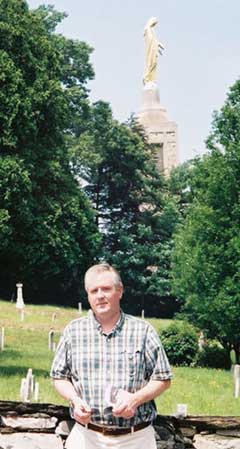 |
|---|
| On a 2008 escape: In the background is St. Anthony's and Mt. St. Mary's Cemetery and the Pangborn Memorial Campanile which rises from the site of Mt. St. Mary's Church (1805-1913). |
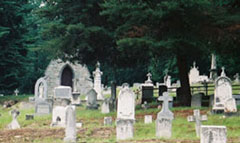 |
| Mother Seton's Son, Wlliam (died 1868) -- who started the cause for his mother's canonization -- and other Seton relatives, are buried in St. Anthony's and Mt. St. Mary's Cemetery. Unfortunately, like many old burial grounds, this one has suffered a lot of vandalism and theft. Very few statues remain. |
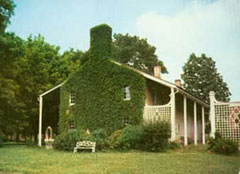 |
| The mid-1700s old stone farmhouse where Mother Seton and her sisters established their school in 1809. It was preserved even after the sisters moved to the fancier "White House" a few years later. This is a 1960s picture taken of the house in its original location along Tom's Creek. Around 1980, the building was moved about a half mile to its present site near the basilica and its stucco covering was peeled off (in the hope that it wasn't holding the house together). The original site and much of what was St. Joseph's College is now the U.S. Fire Administration's National Fire Academy. |
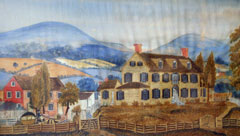 |
| Portion of a tapestry showing the White House as it appeared around 1820. By that year the sisters and their school were being sustained by a thriving farm. |
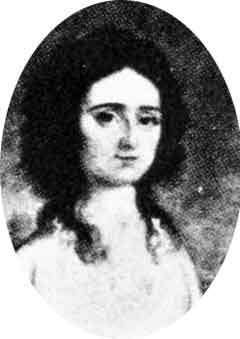 |
Also by Neal J. Conway: |
| Copyright 2012 by Neal J. Conway. All rights reserved. About this site and Neal J. Conway nealjconway.com: Faith and Culture Without The Baloney |